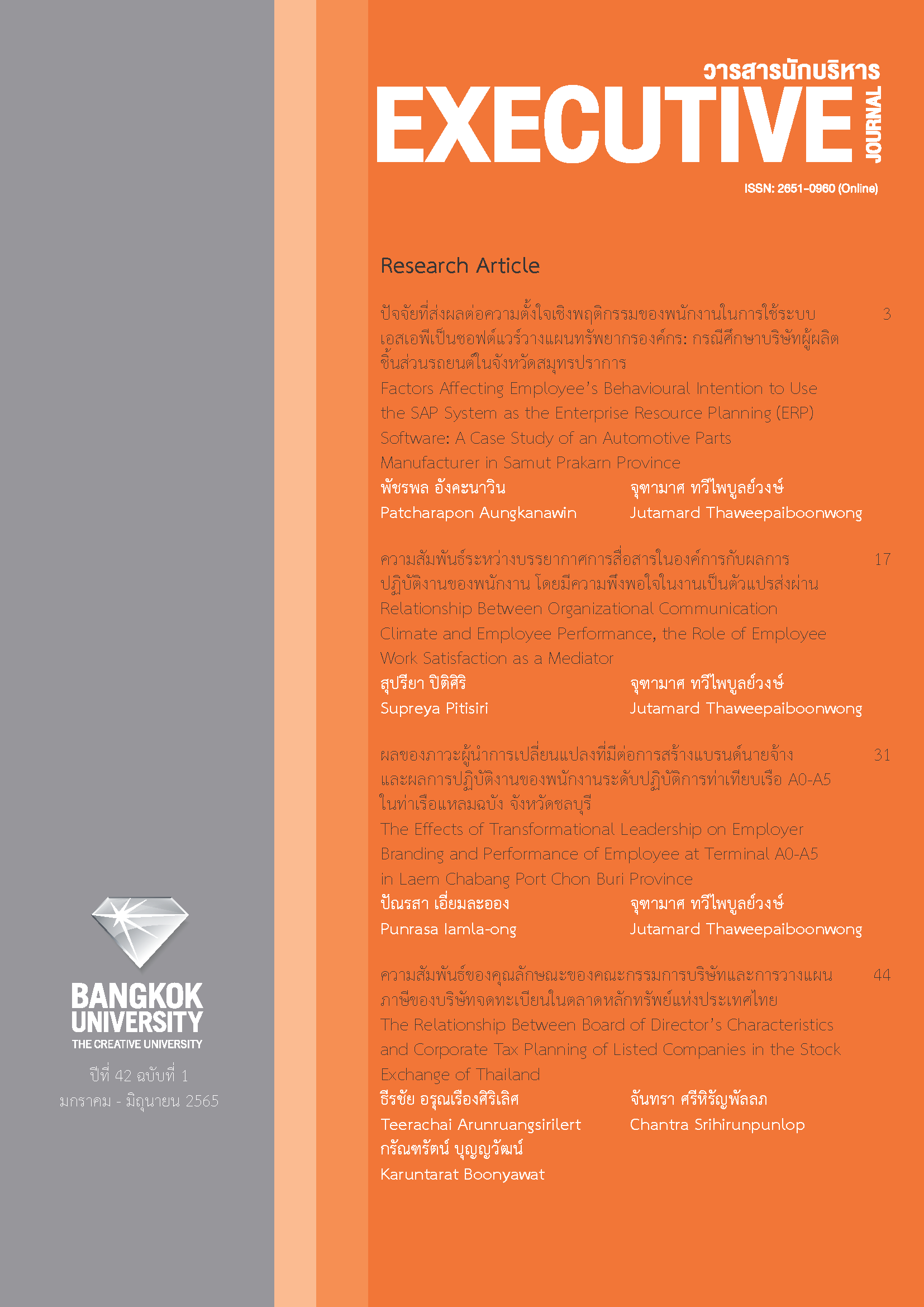Guidelines for Developing Innovations in Management by Using Design Thinking Concept
Main Article Content
Abstract
The global situations in terms of technology, competition, and the domestic and international business environment have changed rapidly. Organizational leaders must be ready to manage these situations, which are challenging for them to understand and adapt to them in a timely manner. This article reviewed the principles and methods of applying design thinking in adapting innovation, and presented the guidelines for implementing this concept by describing five key steps: 1) a survey to create a deeper understanding of the work; 2) an indication/determination to frame problems from involved parties in the work process, and to collect the information received from everyone as well as to find a link to group the problem patterns in the workflow; 3) brainstorming to collect and screen ideas by stimulating the idea of proposing a possible method or approach that will help to comprehensively and deeply consider the problem and also aid to find a concise problem solution; 4) prototype development, in the aspect of management innovation, aiming to create a problem solution prototype or a new working system prototype that will require pilot testing before actual implementation; and 5) implementation, which is the step of testing the prototype to find accuracy and to quickly fix possible problems. Even though it is discovered that the prototype can solve the problem or be a good guideline, it still cannot be completely confident until the prototype is actually tested throughout the organization. This article presented solutions to recurring business problems in creative ways and increases productivity in the workplace by developing new processes and workflows through the use of design thinking that will lead to creating a competitive advantage over competitors.
Article Details

This work is licensed under a Creative Commons Attribution-NonCommercial-NoDerivatives 4.0 International License.
The manuscript submitted for publication must be the original version, submitted only to this particular journal with no prior acceptance for publication elsewhere in other academic journals. The manuscript must also not violate the copyright issue by means of plagiarism.
References
Adair, J. E. (1996). Effective innovation: How to stay ahead of the competition. London: Pan Books.
Alvin, T. (1980). The third wave. New York: William Marrow.
Aujirapongpan, S., Vadhanasindhu, P., Chandrachai, A., & Cooparat, P. (2010). Nawattakam: Khwāmmāi praphēt læ khwāmsamkhan tō̜ kān pen phūprakō̜pkān [Innovation: Terms, classifications, and vital role on entrepreneurs]. Journal of Business Administration, 33(128), 49-65.
Aujirapongpan, S., Vadhanasindhu, P., Chandrachai, A., & Cooparat, P. (2011). Kwāmsāmāt nai kānčhatkān khwāmrū kap khwāmsāmāt thāng nawattakam khō̜ng phūprakō̜pkān thī mīn wat kam nai prathēt Thai [Knowledge management capability and innovativeness of innovative entrepreneurs in Thailand]. NIDA Development Journal, 51(1), 157-199.
Birkinshaw, J., Hamel, G., & Mol, M. J. (2008). Management innovation. Academy of Management Review, 33(4), 825-845. https://doi.org/10.5465/amr.2008.34421969
Chaisanit, S. (2012). Nawattakam læ theknōlōyī [Innovation and technology]. Retrieved December 22, 2020, from https://settachai.wordpress.com/2012/08/13
Chienwattanasook, K., & Jermsittiparsert, K. (2019). Effect of strategic planning process on performance of pharmaceutical manufacturing SMEs in Thailand with moderating role of Competitive Intensity. Systematic Review in Pharmacy, 10(2), 165-175.
Christensen, C., Raynor, M. E., & McDonald, R. (2015). What is disruptive innovation. Retrieved December 18, 2020, from https://hbr.org/2015/12/what-is-disruptive-innovation
Christiansen, J. A. (2000). Building the innovative organization: Management systems that encourage innovation. Hampshire: Macmillan Press.
Design Council. (n.d.). What is the framework for innovation? Design Council's evolved Double Diamond. Retrieved December 18, 2020, from https://www.designcouncil.org.uk/news-opinion/what-framework-innovation-design-councils-evolved-double-diamond
Henk, W. V., Frans, A. J., Van Den, B., & Cornelis, V. H. (2013). Management innovation: Management as fertile ground for innovation. European Management Review, 10(1), 1-15. https://doi.org/10.1111/emre.12007
Hughes, C. (2003). What does it really take to get into the Ivy League & other highly selective colleges?. New York: McGraw- Hill.
Jaitip, C., & Chienwattanasook, K. (2018). Sakkayaphāp khō̜ng phū nam ʻongkō̜n thurakit nai sathānakān lōk thī mī khwām phanphūan khwām mai nǣnō̜n khwām sapsō̜n læ khwām khlumkhrư̄a [The capacity of business leaders in a global situation characterized by volatility, uncertainty, complexity and ambiguity]. Burapha Journal of Business Management, 7(1), 1-14.
Jarinto, K., Chienwattanasook, K., & Jermsittiparsert, K. (2019). A theoretical and empirical framework for knowledge sharing: An auto industry case-study. International Journal of Innovation, Creativity and Change, 10(1), 406-425.
Kelley, T., & Kelley, D. (2013). Creative confidence: Unleashing the creative potential within us all. New York: Crown Publishing Group.
Kotter, J. P. (2007). Leading change: Why transformation efforts fail. Boston: Harvard Business Review.
Ladavalya Na Ayuthya, S. (1997). Nāthī thāngkān bō̜rihān [Administrative duties]. Chaing Mai: Dao Printing.
Namburi, S. (2019). Nawattakam læ kānbō̜rihān čhatkān [Innovation and administration]. The Journal of Research and Academics, 2(2), 121-134.
National Innovation Agency (Public Organization). (2010). Kānčhatkān nawattakam samrap phūbō̜rihān (Phim khrang thī 3) [Innovation management for executives (3rd ed.)]. Bangkok: National Innovation Agency.
Navikarn, S. (1995). Kānbō̜rihān (Phim khrang thī 2) [Administration (2nd ed.)]. Bangkok: Dok Yha.
Robbins, S. P., & Coulter, M. (2002). Management (7th ed.). Englewood Cliffs, NJ: Prentice-Hall.
Schweitzer, J., Groeger, L., & Sobel, L. (2016). The design thinking mindset: An assessment of what we know and what we see in practice. Journal of Design, Business & Society, 2(1), 71-94. https://doi.org/10.1386/dbs.2.1.71
Tungpakdeetrakool, A., & Waranusantikule, S. (2017). Kānsưksā khwāmsamphan khō̜ng khwām phrō̜m tō̜ kān plīanplǣng phrưttikam kān pen samāchik thī dī nai ʻongkān læ phrưttikam tō̜tān kān patibat ngān dōi mī thun thāng čhittawitthayā pentūa kap [The relations between readiness for changes, organizational citizenship behavior and counter productive work behavior with positive psychological capital as a moderator]. Academic Journal of Humanities and Social Sciences Burapha University, 25(48), 295-315.
Wangdee, A. (2018). Sāng kānraprū nawattakam phư̄a kānphatthanā [Create an awareness of innovation for development]. Retrieved December 22, 2020, from http://landinfo.mnre.go.th/attachment/iu/download.php?WP=nKI4nKN4oGA3ZHkCoMOahKGtnJg4WaN5oGO3A0j5oH9axUF5nrO4MNo7o3Qo7o3Q
Zhang, Y., Khan, U., Lee, S., & Salik, M. (2019). The influence of management innovation and technological innovation on organization performance. A mediating role of sustainability. Sustainability, 11(2), 495. https://doi.org/10.3390/su11020495


